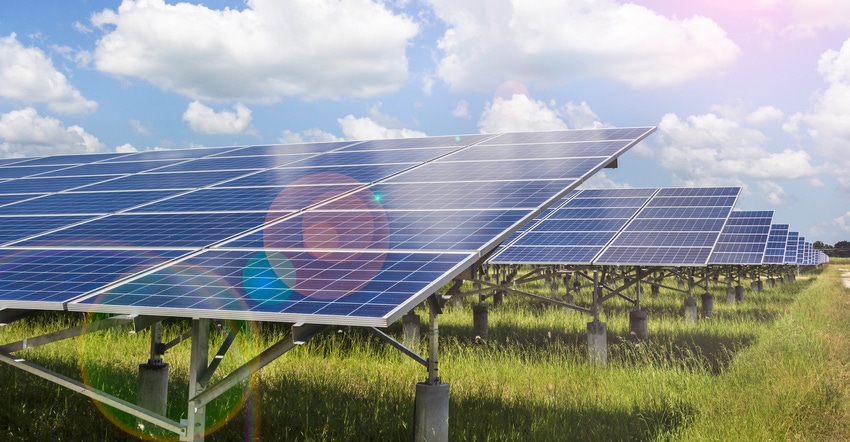November 22, 2021

We invited readers to weigh in on the solar debate with this editorial that also ran in the November issue of Indiana Prairie Farmer. However, we laid down ground rules: Any replies needed to be civil. So far, those picking up the conversation are complying.
The fact is that at least two large solar installations are either under or near construction in Indiana, with several more approved or in the discussion stage. We will continue to explore the pros and cons of these installations. We look forward to your comments — just remember the ground rules.
Related: Reader shares questions about solar energy
This letter to the editor was written jointly by Connie Ehrlich and Gail Lambert. Ehrlich lives in Lafayette but owns farmland in Pulaski County, Ind., and is the fourth generation involved in agriculture. Two of the proposed projects are close to Lambert’s home in Pulaski County. Her grandson is the sixth generation to live on a section of the family farm. The letter was edited to meet space requirements.
Letter to the editor
Dear editor:
Thank you for your willingness to have a discussion regarding large commercial solar energy systems on ag land. Few people are willing to look past the potential opportunity for money to see the impact large scale solar will have in our communities.
Solar energy generation is a poor source of energy for multiple reasons. Solar energy has one of the lowest efficiency ratings of renewable energy sources. Multiple sources state an 11% to 15% energy rate for solar. The highest efficiency rating we found was 21%. Solar and wind are not reliable sources to produce energy, which we require 24/7/365. Very little, if any, is produced when the sun isn’t shining, and the wind stops blowing. We need more reliable sources of energy.
Nuclear energy is a clean, renewable and reliable source of energy, with an extremely high efficiency rate. However, the federal government is spending millions of taxpayer dollars to promote solar and wind generation, with very little mention of nuclear generation. Why?
Solar energy requires more land per megawatt, with only hydro being worse. Solar takes approximately 9.3 acres to produce 1 megawatt. Nuclear energy requires a small fraction of land to produce the same megawatts and is far more dependable and predictable.
Northern Indiana is one of the lowest areas for sun exposure, with only 10 states with less sun exposure. On average, northern Indiana has only 83 days of sunshine per year. It will require more solar panels and land in states with less sun exposure.
Solar and wind generation will create a horrendous issue with disposal of solar panels and wind turbines in the very near future. Currently, the U.S. does not have an answer to properly dispose of solar panels. Studies show life expectancy is approximately 40% less than originally forecast. Technology will also cause solar panels to become obsolete.
Solar developers state their panels will not contain any toxic materials. However, solar panels are considered hazardous material and currently not allowed in landfills. An attorney for NextEra recently stated during a public hearing that she has faith in the private sector that a solution will be found to dispose of them. Doral Renewables, an Israeli company, has installed solar panels for 13 years abroad and says they don’t have an answer to the waste created by this clean, renewable energy source.
Project details
Mammoth Solar is claiming its first U.S. solar project, planned for Starke and Pulaski counties, will be the largest in the U.S., producing 1.3 gigawatts, involving 13,000 acres of farmland.
Moss Creek Solar LLC recently received approval from Pulaski County’s Board of Zoning Appeals for its solar project, generating 200 megawatts and removing another 1,600 acres from crop production. To date, 10,381 acres have received approval from the BZA. The county has received calls from up to nine other solar developers.
Pro-solar “yaysayers” claim farmers have the right to do whatever they want with their ground. However, their property rights end when their decisions affect neighboring properties and limit their neighbors’ opportunities to successfully utilize their property. Some rural homes will be surrounded on one, two or three sides by solar panels. Do solar landowners have the right to negatively impact neighboring property values?
Solar developers use the Cohn Reznick study to justify their claim that property values will not be negatively impacted. That study cites significantly smaller solar installations and locations are not comparable. Isn’t protecting all landowners’ property rights one of the major reasons we have zoning laws?
Pulaski County and many other counties’ ordinances do not limit the number of acres that could be removed from agriculture for solar energy. Solar-friendly ordinances make those counties easy targets for solar developers … who prey on financially struggling counties.
One major issue of removing large acreages from crop production is the “ripple effect” on local businesses and communities that support agriculture. Counties are quick to accept solar applications without conducting economic impact studies. Pulaski County is a rural community which depends on ag and supporting ag businesses. Removing over 10,300 acres will negatively affect most local businesses.
Solar energy generation is not the best use of prime farmland groomed and developed for crop production. Many acres have tiles, wells and irrigation systems. Solar developers pitch the idea that the ground needs rest. It is questionable if the ground will be suitable for crop production after 30-plus years of “resting.”
Solar developers’ land contracts are very long. One contract is 30 years, with a renewal clause for an additional 30 years at the sole discretion of the solar developer. The landowner had lost control of their ground for potentially 60 years.
To learn more, visit our website: pulaskicountyagainstsolar.org.
Sincerely,
Connie Ehrlich and Gail Lambert
Read more about:
SolarYou May Also Like




